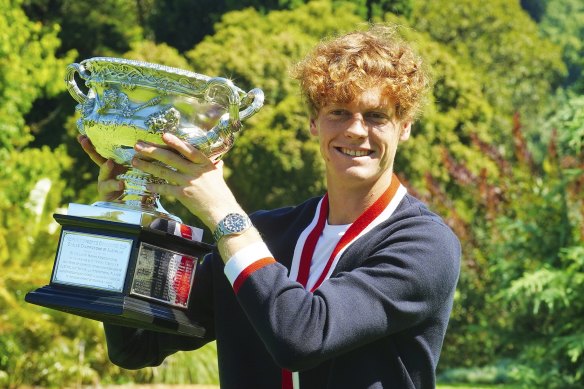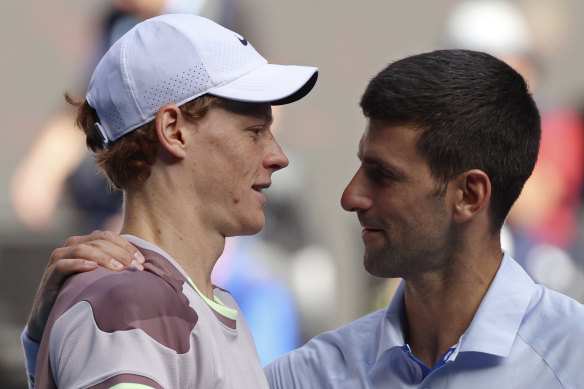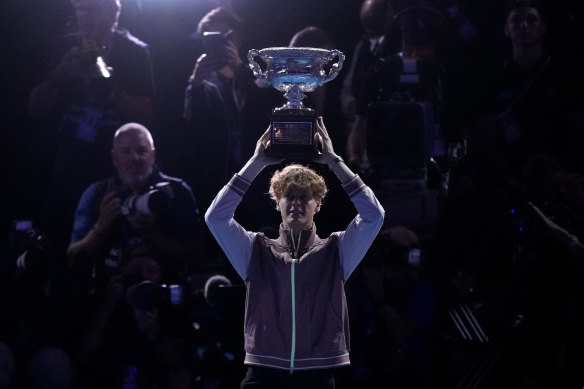This was published 2 months ago
Jannik Sinner says tennis needs generational change. The 22-year-old is leading the way
By Scott Spits
As the Australian Open broke new ground and celebrated just the fifth different player to hold the men’s trophy aloft since 2005, even the game’s newest champion recognised that his Melbourne victory might be a game-changing moment.
“The next generation is something that this sport needs,” said Italian Jannik Sinner who, aged 22, is the youngest men’s champion in Melbourne since Novak Djokovic 16 years ago.

Jannik Sinner basks in the glory of his Australian Open win in Melbourne’s Royal Botanic Gardens on Monday.Credit: Luis Enrique Ascui
Sinner joined the grand slam club with his epic come-from-behind five-set victory over Daniil Medvedev, announcing himself as one of the sport’s best, even it didn’t shift him from his world No.4 ranking – for now anyway.
The Italian’s grand slam triumph was highlighted by a landmark four-set elimination of Djokovic in the semi-finals, ending the Serbian’s six-year unbeaten streak in Melbourne.
Sinner was not prepared to declare an end to the sport’s “Big Three” era – a remarkable 20-year period when Roger Federer, Rafael Nadal and Djokovic won the bulk of the majors on offer by some distance – but his satisfaction about being a vital part of the sport’s new generation was clear.
Sinner and 20-year-old Wimbledon champion Carlos Alcaraz should no longer be billed as the future of their sport, they are the here and now.
“It’s quite unpredictable what’s coming in the future, but still, it’s nice to be part of this generation,” Sinner said as he was photographed with his trophy in Melbourne’s Royal Botanic Gardens on Monday.
“I think the next generation is something that this sport needs, and it’s also a little bit of a game-changer.”
Djokovic won the first of his 10 Melbourne Park titles in 2008. Although Sinner comprehensively outplayed the 24-time major champion, he was not inviting comparisons with the legendary Serbian on Monday as he got accustomed to winning his first grand slam.
“He is a different league,” Sinner said.

Jannik Sinner’s semi-final defeat of Novak Djokovic might prove to be a changing-of-the-guard moment in world tennis.Credit: AP Photo
“I’m just happy I have this trophy for this year, and then we see what’s coming. There is still a lot of work to do, but I will enjoy my process, and then we see what I can achieve in the future.”
This year’s Open also heralded an era of a different kind – the first time more than 1 million spectators pushed through the Melbourne Park turnstiles for the January extravaganza.
That landmark figure was partly achieved by the move to a 15-day tournament, with the event starting on a Sunday and tournament action stretching across three different weekends.
The event still had its customary late-night finishes thanks to some marathon matches played back-to-back on Rod Laver Arena
Men’s runner-up Medvedev ended his second-round match against Emil Ruusuvuori at 3.39am, and still had time to sign autographs. The Russian endured an ultra-marathon version of the Australian Open, spending more than 24 hours on court across his seven matches.
But tournament director Craig Tiley said recovery time for players had, on average, increased this year.
“By starting on a Sunday, we took the edge off the challenge you have at the beginning of the event, having long matches,” Tiley said.
“The average recovery time between matches was two hours longer than it normally is, which is really significant.”
Medvedev and Ruusuvuori walked onto Rod Laver Arena at 11.07pm after the previous match featured the longest tie-breaker ever in a women’s grand slam event.
Tiley also cited the unpredictable nature of one of the quarter-final days when Djokovic’s day-time clash against Taylor Fritz finished well into the evening. That match was preceded by American star Coco Gauff’s lengthy quarter-final.
“You wouldn’t expect that with the length of her [Gauff’s] matches on average throughout the year,” said Tiley.
“But that’s just how it is. You’re going to have that [some long days].”
Tiley was also rapt with the new spectator movement policy, which allowed patrons to leave and enter stadiums easier, instead of forcing them to wait until the players change ends. He said players had largely adapted to the change.
“What we trialled this year was to enable our fans to come into the stadium and not be stuck waiting for the gates to open after the first game, third game, fifth game,” Tiley said.
“Sometimes if the line’s really long you can wait for 20, 30 minutes. That’s not a good experience.
“It’s about getting the players used to a bit more movement. [While] you need be respectful of not distracting the players, we do want our fans to sit down, particularly on the north and south ends of the court [behind the baselines].

Jannik Sinner hoists the Australian Open trophy aloft.Credit: AP
“But generally, the first few days was [about] getting used to it. Really, last week we had no comments from any of the players.
“The comments we did hear from the fans was that it was fantastic; they feel they could quickly go to the bathroom and find a way to get back and not be distracting.”
Tiley said that matches across the main draws in the tournament – singles and doubles – were, on average, two minutes longer this year compared to 2023.
He said the sport broadly needed to focus on ways to speed up the game.
“We will consistently look for ways to make sure that we reduce that [scheduling] pressure,” he said.
“One of the ways could be [getting rid of] lets [on serve]. You could [also] look at the player warm-up – is it too long?
“But these are all things the sport needs to address, not just the Australian Open. And it really needs to be driven by the players.”
News, results and expert analysis from the weekend of sport sent every Monday. Sign up for our Sport newsletter.